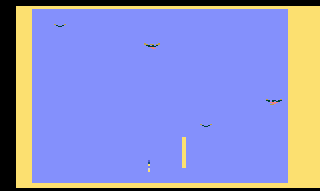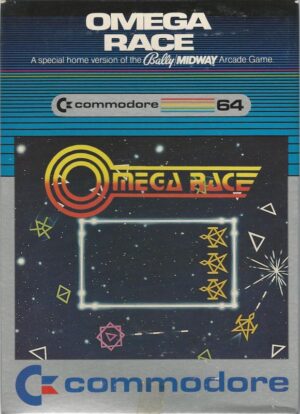Retro Replay Review
Gameplay
SwordQuest: FireWorld largely mirrors the design philosophy of its predecessor, EarthWorld, by blending room-to-room exploration with light action sequences. You’ll traverse various chambers in search of key artifacts, often picking up items in one room only to drop them in another to trigger hidden clues. This core loop creates a methodical pace that rewards careful observation and experimentation.
Interspersed with the maze-like navigation are brief but challenging action stages. These segments test your reflexes as you battle fire-themed foes and avoid environmental hazards. While not as deep as dedicated action titles, they provide a welcome change of pace from the more cerebral puzzle segments and help keep the player engaged.
Perhaps the most distinctive gameplay element is the numeric flash puzzle. When you’ve collected the correct combination of items and placed them in the right rooms, a pair of numbers briefly appears on-screen. Deciphering these numbers—by consulting the accompanying comic book—unlocks further progress and brings you one step closer to claiming ultimate victory in Atari’s contest.
Overall, the gameplay strikes a careful balance between exploration, item-based puzzles, and occasional arcade-style bouts. It demands both patience and attention to detail, making it a satisfying experience for players who enjoy unraveling mysteries rather than barreling through levels at lightning speed.
Graphics
Given the Atari 2600’s hardware constraints, FireWorld does a commendable job of painting a fiery realm with simple sprites and vibrant color schemes. Walls and floors alternate between deep reds and oranges, evoking a sense of heat and danger as you delve deeper into the game’s infernal chambers.
Character and enemy sprites are basic but clearly defined. Your avatar stands out against the background, and the fire spirits or lava creatures you encounter have just enough animation to feel dynamic. Though minimalist by modern standards, the graphics possess a retro charm that will resonate with fans of classic consoles.
The numeric flashes, while fleeting, are rendered in sharp contrast to the environment, ensuring you don’t miss a critical clue. Action segments introduce a slightly higher frame rate, making dodging hazards feel responsive despite the Atari’s limited processing power.
In sum, FireWorld’s visual presentation maximizes what the 2600 can offer. The deliberate color palette and crisp, if rudimentary, animations transport you into a world of flame and mystery without unnecessary frills.
Story
Unlike many modern adventure games, SwordQuest: FireWorld relies heavily on its supplementary comic book to convey narrative context. In-game, your quest is succinct: recover the FireSword by solving elemental puzzles scattered throughout the realm of fire. Yet the comic fleshes out motivations, backstories, and the lore behind the elemental gemstones.
The brief in-game text gives just enough exposition to guide your next objective, but it’s the interplay between cartridge and comic that truly brings the storyline to life. Each numeric clue points you to a specific page and panel, where a hidden word awaits. As you piece together these words, you uncover fragments of the FireWorld saga.
While the raw in-game storytelling is minimalistic, this design choice encourages a more immersive, cross-media experience. You’re not just playing a videogame—you’re participating in an interactive treasure hunt that spans digital and print realms, a concept that was groundbreaking for its time.
Ultimately, the narrative payoff depends on your dedication to the contest and the labor of hunting through the comic. For those willing to dive in fully, the story becomes a rewarding journey of discovery rather than a straightforward linear adventure.
Overall Experience
SwordQuest: FireWorld stands as a unique relic of gaming history—part adventure, part puzzle hunt, and part comic-driven contest. The novelty of decoding numeric flashes to win real-world glory adds an extra layer of excitement that few titles have replicated since.
For retro enthusiasts and puzzle aficionados, the game offers a satisfying blend of methodical exploration and occasional action challenges. The requirement to reference an external comic book elevates the experience into an immersive scavenger hunt, rewarding players with the thrill of real-lifeworld detective work.
However, casual gamers seeking fast-paced thrills or deep narrative arcs may find the gameplay loop repetitive and the reliance on print materials cumbersome. Without the comic book and contest, many puzzles could feel opaque, and progress might stall without diligent note-taking and cross-referencing.
In conclusion, if you appreciate retro charm, enjoy piecing together cryptic clues, and don’t mind trading some on-screen storytelling for an out-of-game adventure, SwordQuest: FireWorld is a captivating experience. It remains a standout example of Atari’s ambition to blur the lines between gaming, puzzles, and real-world prizes.
 Retro Replay Retro Replay gaming reviews, news, emulation, geek stuff and more!
Retro Replay Retro Replay gaming reviews, news, emulation, geek stuff and more!









Reviews
There are no reviews yet.